SPIDERS
page 6--Fishing Spiders
This
page was born 9/13/2004. Rickubis designed it. (such as it
is.) Last update: 04/14/2022
Images
and contents on this page copyright ©2002-2022 Richard M. Dashnau
Go back to my home page, Welcome
to rickubis.com
Go
back to the RICKUBISCAM page.
As
I get more pictures of spiders,
I'll be putting them here. I'll try to give some information as well. I
recommend a book I've bought recently to anyone who is interested in spiders.
The title is: Biology of Spiders, by Rainer F. Foelix, published in 1996.
This has a lot of information on spider biology. This is not an identification
guide, but is filled with detail on
how spiders do what they do(Since they're
"spiders" do they "spide"? Is what spiders do called "spiding"? Probably
not. It's just another mystery of the English language.). On
November 23,
2003, I moved all the information on Golden Silk Spiders to another page.
05/30/2021 (posted 6/07/21) I'd signed up for a shift at the Brazos Bend State Park Nature Center. Unfortunately, a storm the day before blew down a tree
which
took down some power lines--which cut off power to the Nature Center.
Therefore, we'd set up a few tables just outside of the entrance,
and we had various materials set
out for interpretation. There
was a live alligator, which one of the other volunteers was handling.
I was handling a snake. We talked to visitors, and were
undoubtably
very interesting. But something else
was out there that caught the attention of many of the folks that came
by. About 8 feet above ground, clinging to some of the exterior
trim, was
a large, brown spider. I took a few zoomed-in
pictures of the spider, because I didn't want to get closer and risk
disturbing it. (also, it was 8 feet above ground, so I couldn't
get
much closer anyway.) I'm pretty sure I recognized the species
(one of a few I think I know), and I know that these spider can move
very quickly if disturbed. To get some
idea of the size of
this spider, consider that it is standing on a board that is at least
1/2 inch thick. The first picture was taken while I looked up at
if from some distance. I took the
second and third pictures while looking up from under it.
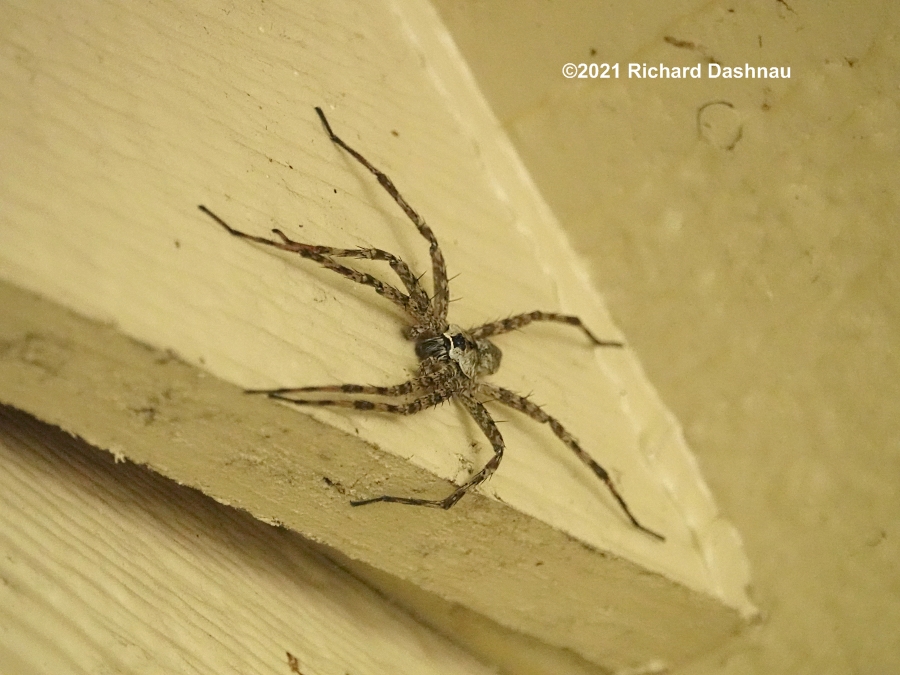
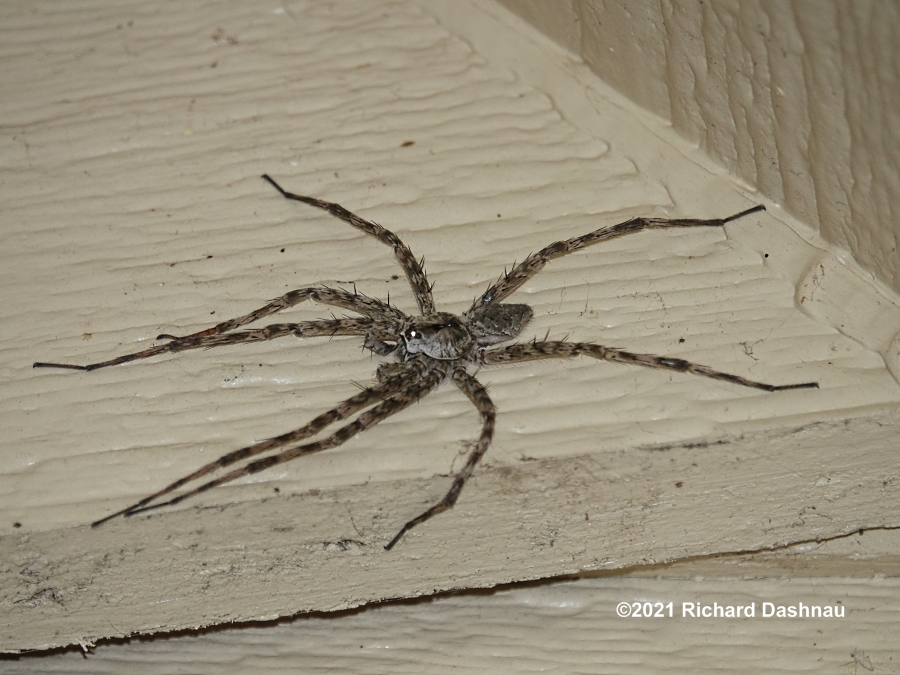
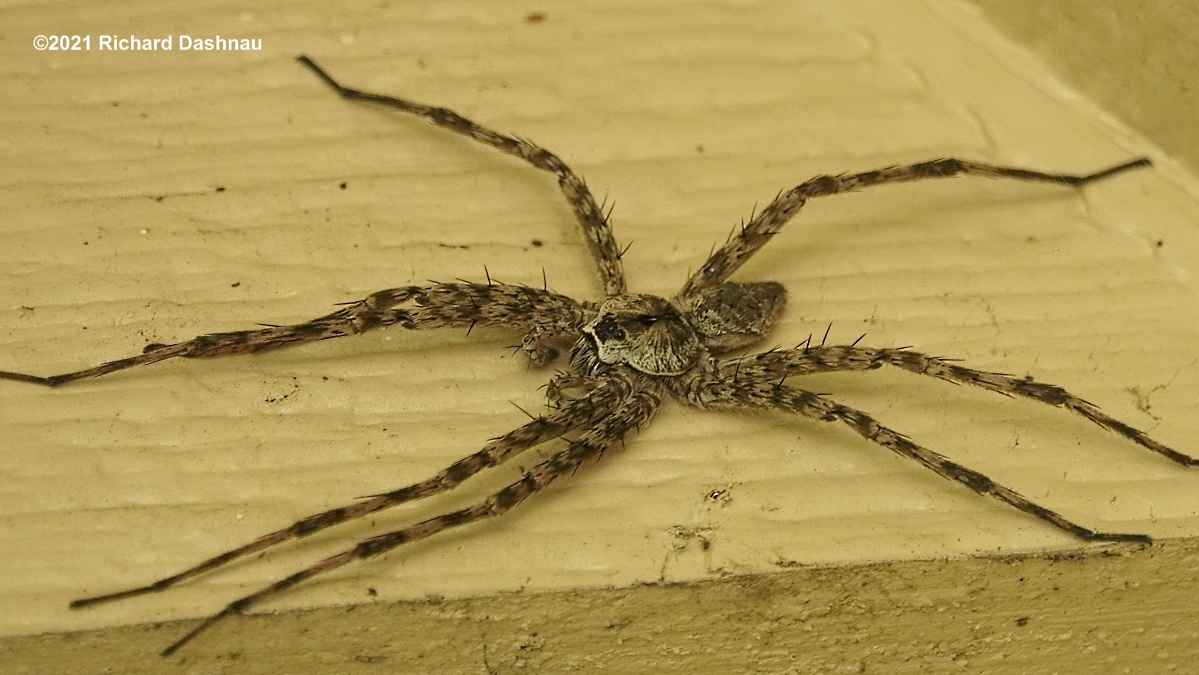
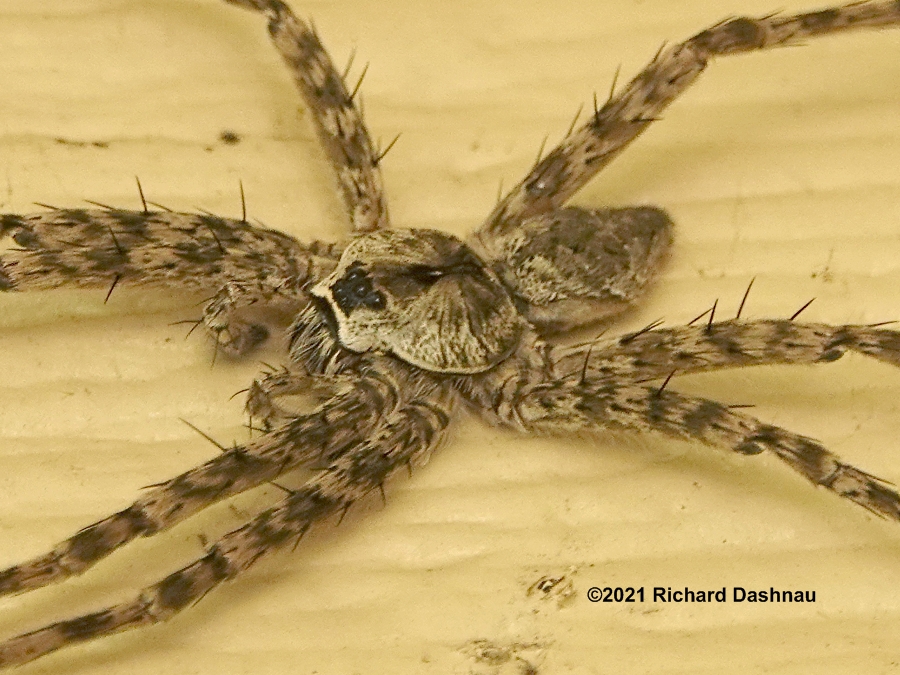
I
think this spider is in the genus Dolomedes, and I believe so mostly
because of the arrangement of its eyes. Dolomedes spiders have 8
eyes in two rows at the front of its cephalothorax.
The top row
has 4 eyes, in a row that curves slightly, just above another row of 4
eyes in a straight line. At some distance, I've always thought it
looked like these spiders are always frowning.
I know that they aren't
frowning, but it looks like it. The Dolomedes genus are also
known as "fishing spiders", and some species actually do catch fish.
Some species, like this one,
are sometimes found far away from
water. I think this might be a Dolomedes Tenebrosus, or "Dark
Brown Fishing Spider aka Brown-Ringed Fishing Spider aka Dock Spider".
Fishing
spiders do not capture their prey with webs (as orb weavers or funnel
web spiders do), but stalk and pounce on it. I've mentioned Fishing
Spiders on my website before, but the
last time I did was back in 2004!! My Fishing Spider page is here.
August
23, 2004The
image below (FISHING FOR QUARTERS?) shows a spider that I've seen from
time to time, but haven't been able to observe; and it's with a quarter.
---------------------------------------------------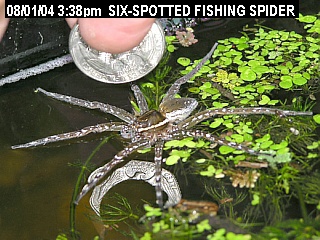
FISHING FOR QUARTERS?
Recently,
the VC/NC at Brazos Bend State Park got a new "pond life" aquarium, set
up by David Heinicke.
About
once a week, nets are taken to the various lakes around the park, and some
of the zoological specimens found are added to the aquarium. It is fascinating
to see what we have!
Among
the animals in the aquarium is the subject of todays RICKUBISCAM. This
is a Six-Spotted Fishing Spider (Dolomedes Triton), and a very nice one.
It's very difficult for me to photograph
inside the aquarium, but I was
able to get a few pictures of the spider.
Some
of the more observant visitors to rickubis.com might recognise the Dolomedes
genus from other pictures I've
shown; and they'd be correct. Many of the
Dolomedes species are called "fishing spiders", although from what I've
been able to find; only this one, Dolomedes Triton, actually catches fish!
These spiders are difficult to observe for a number of reasons. They hide
well.; they run very quickly, even on top of water; AND, they hide
(and hunt!) under water as well. One of the times I
tried to photograph
this
one (the pictures here were taken on different weekends in August), it
decided it had enough, and ran under one of the lily pads and stood upside
down....under the
water. If I was walking by outside, I'd never see
this spider, of course. Below are more pictures. In the cropped
closeups, note the 2 rows of 4 eyes; the bright stripes on the upper edges
of the
cephalothorax (or prosoma) (and the top shield on this is called
a "carapace"; the same term used to describe a turtle's upper shell.) Strangely,
there are about *twelve* white spots on top of the
abdomen (or opisthosoma);
and six large black spots on the sternum (underside of the cephalothorax).
I suppose this is where the common name came from.
(identification
key from "How to know the Spiders, 3rd edition, by B.J. Kaston.)
- 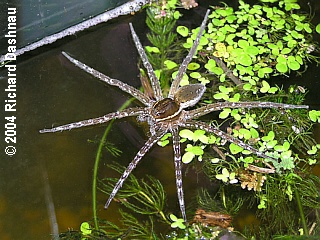 -
- 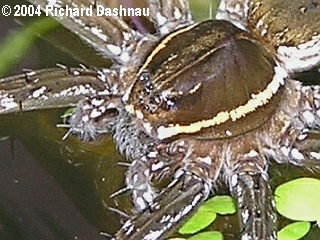
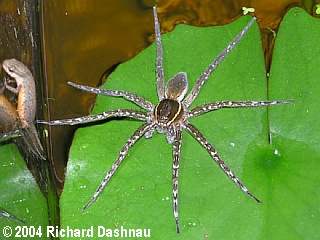 -
-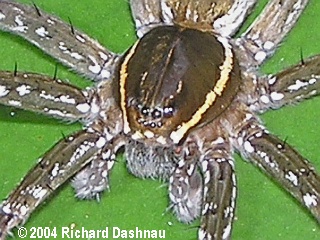 -----
-----
D. TRITON OBLIQUE VIEW D. TRITON
OBLIQUE CLOSEUP D. TRITON UPPER FRONT VIEW
D. TRITON UPPER FRONT CLOSE UP
The
two pictures below, although not a clear as I'd like, do show the
spider eating one of the small fish in the tank. By the time I was told
about it (and poeple look in this tank all day--it's very
interesting)
the spider was already eating the fish. I'd certainly like to see exactly
how the spider snags a fish. Update 12/16/2012-The fish that the spider has caught is most likely a
Golden Topminnow (Fundulus chrysotus). This link shows some identification features. The gold spots on the fish identify it as a female of the species.
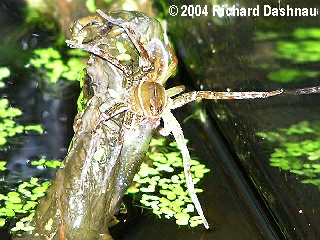 -
-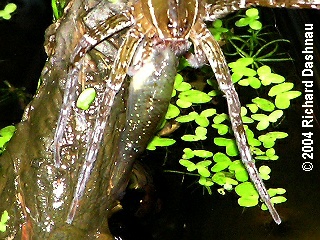 --
--
D.TRITON EATING
FISH
D. TRITON W/ FISH-- CLOSER
July
18, 2004I've
been watching for the Dolomedes Albineus around the VC/NC. I didn't find
any, but I *did* find this spider which seems to be a Dolomodes Tenebrosus
on one of the outside columns.
(See LARGE, SPARSE HAIRS, below)
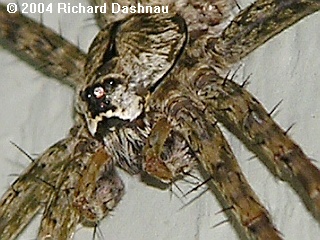
lLARGE, SPARSE HAIRS
July
12, 2004I
guess it's time for a few more spider pictures. The image below (READY
FOR MY CLOSEUP) is a closeup of a spider that was hiding on one of the
deck benches outside the
Visitor's Center at BBSP. Notice the two
rows of eyes, all about the same size. Also notice that the top row has
a "curve" to it. This eye arrangement is one of the identification keys
for the
Dolomodes species of spiders. I was pretty sure that this is another
specimen of the Dolomedes Tenebrosus, one of the "nursery web spiders",
or "fishing spiders" (but it isn't. see the
update
below). Compare with the pictures
one of my other webpages.
These spiders are active hunters and they also carry their egg sacks in
their jaws. As the picture below shows (DOLOMEDES
W/ QUARTER), it's a pretty
good-sized spider. While lying on the sidewalk, I was able to look up and
get some good pictures of the front of the spider. (see FROM BELOW, and
CLOSER,
below). Notice how from this angle, you can see how it has clamped
its left and right third legs around the 2 x 4 that supports the bench.
--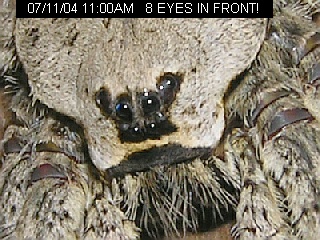 --
--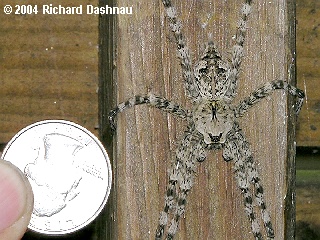 --
--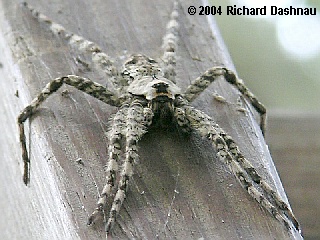 --
--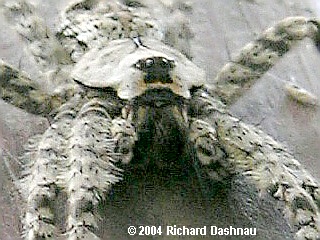 -----
-----
READY FOR MY CLOSEUP
DOLOMEDES WITH QUARTER
ALBINEUS FROM BELOW
CLOSER ALBINEUS
Update,
July 13: Well, I was pretty sure, but as I started thinking about
it; I considered that this spider was a lighter shade than my picture of
the Dolomedes tenebrosus. I started thinking that it
resembled more
the picture of the Dolomodes albineus, at the top of my
other web page. What else could I do but see if I could ask the "high
priestess of Dolomedes". ms. Kelly Kissane (at
http://www.dolomedes.org)
once again. So, I sent ms. Kissane this email:
"Last
Sunday, we had another visit from one of your favorite spiders. I'm pretty
certain that it's a dolomedes, because of the eye pattern, but I'm not
sure if it's a tenebrosus or an albineus. I've
seen one of each and sent
(you) pictures before. And I kind of off-handedly called this one a tenebrosus...but
on further thought I'm considering that its color is wrong. <snip>
Anyhow,
can you help me with this, and perhaps give me any readily-visible identification
keys that give away
the
difference between the two spiders, d. tenebrosus, and d. albineus?"
And,
ms. Kissane was kind enough to send this answer:
"
You have, without a doubt, Dolomedes albineus. My favorite species.
They live in trees and are absolutely beautiful spiders. Almost nothing
is known about them, unfortunately.
You can
tell the difference between D. albineus and D. tenebrosus by the coloration.
Only D. albineus is whitish, with extra hairs that make it look fuzzier
than other Dolomedes. D. tenebrosus is
brownish (some variation in
hue, however) with orange annuli (the rings of lighter color in the legs).
Both speces are large, however."
So, there
it is. Another Dolomedes albineus, known sometimes as a "Whitebanded Fishing
Spider"! Thank you very much, Kelly! Here's something interesting. This
spider was on a bench about
30 paces away from where I saw the other D.
Albineus fell to the ground from a Live Oak on July 7, 2002!. Today's was
on a bench under a live oak (possibly the same one, since the upper
branches
of the two live oaks-both over 150 years old-are mingled together). Two
years, almost to the day!
Below
are two closeups of the spider. Note the extremely hairy leg segments-
-especially
the 3rd from the body, the "femur"-- compared to the Dolomedes Tenebrosus
above and below. For some photos showing parts of the spider anatomy
labeled, go to my Spiders
Page 3.
--------------------------------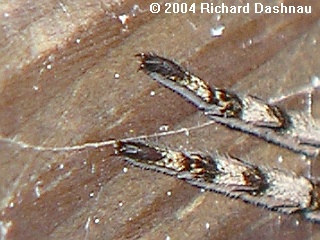 ---------------------
---------------------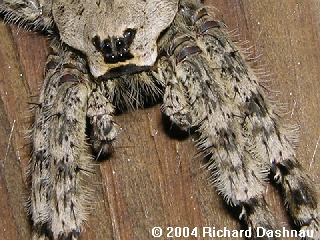
TARSAL
CLAWS
EXTREMELY HAIRY LEGS
September
4, 2002 Last Monday, Labor Day, I was
at the park, doing park things, when John drove up in one of the gators.
He told me about a large spider that he saw inside one of the water
stations on the Spillway trail. Not long after that, Herb mentioned the same spider. So, I
stopped by this water station, and looked inside. I did't see any
spider, and started to stick my head in,
but then decided I might not like
a large, annoyed spider of indeterminate species jumping down onto
the back of my neck. So, I carefully looked again, and then I found it.
With a little
maneuvering I was able to get some pictures. One is below.
----------------------------------------------------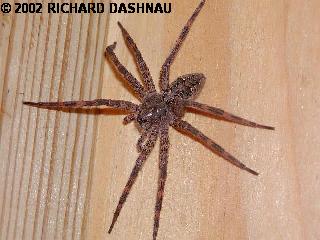
I suspected
that this was another spider of the Dolomedes genus. So, I decided to ask
the "high priestess of Dolomedes", Ms. Kelly Kissane.
Here
is part of my email to her:
....Here's my story. Yesterday, two people told me about this "big spider"
that was hiding in our little water station.
They knew I like to take pictures of them. So, I looked, and found it hiding
up against the ceiling. The picture with it
against the end of the board shows where I found it. That wood is about
1-3/8 inches to a side. I blew on the spider,
and it moved onto the wall, allowing me to get the other shot. I'm
reluctant to bother the animals too much, so that's
all I did. I was lucky to get the shots I did, considering I had to reach
inside the box while
holding the camera.
Am I right in guessing that this is a Dolomedes Tenebrosus? The body shape
and the "frowning face" eye
arrangement seems similar to our other friend's (D. Albineus). Also, that
pattern on the rear segment
(abdomen/opisthosoma) seems like what I can see in the guidebook. Since
I think it's a Dolomedes, I figured
you'd be the person to ask....
And here
is her answer:
Rick,
That's definitely Dolomedes tenebrosus - a large female. The males
are less than 1/2 that size
(sometimes they're 1/4 the size of the female)....
Kelly
So, there's
the story. I've been fortunate (some may not agree) to be able to see two
different spiders in the genus Dolomedes.
Between 9/14 and 10/18, 2002
I went back to the water station to visit the dolomedes, and took more
pictures. Some of these came out well.
On September
20, it was still inside the water station. I was able to take
some good closeups. (see FACE AND PEDIPALPS, TWO ROWS OF 4, and WITH A
QUARTER, below.)
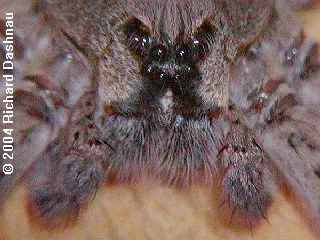 -
-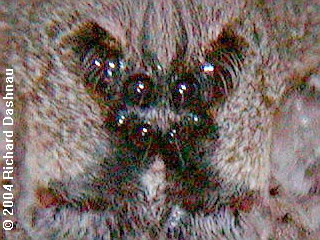 -
-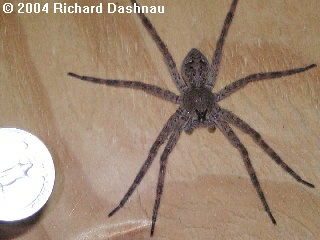 -
-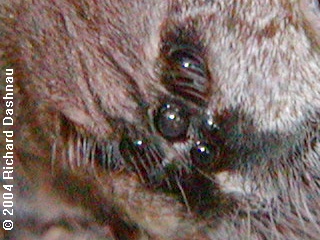
FACE AND PEDIPALPS
TWO ROWS OF FOUR
EYES
WITH A QUARTER
EYES FROM THE SIDE8
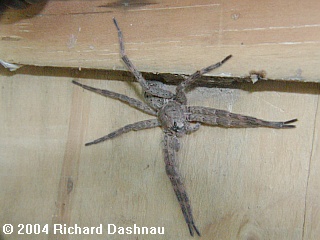
LEG ESTABLISHING
SHOT
On September 28 I saw it clinging
to the inside of the door of the water station. The three images
(see LEG ESTABLISHING, above; and TWO CROSSED LEGS, and TARSAL SEGMENTS,
below.) Show the end segments the last of 7, on a spider's leg. Note the
widely-spaced, hooked claws on the ends of the legs, which don't seem to
be holding onto the wood.
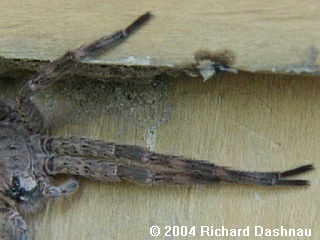 -
-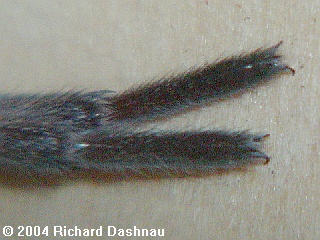 -
-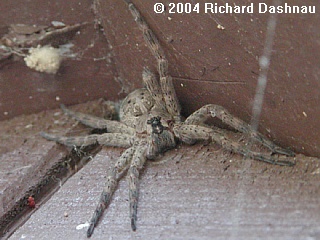 -
-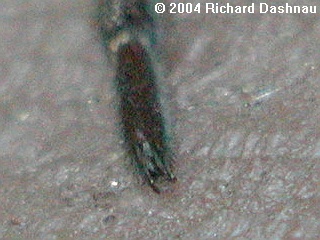 -
-
TWO CROSSED LEGS
TARSAL SEGMENTS
LOOKING DOWN ON ME
LOWER RIGHT LEG
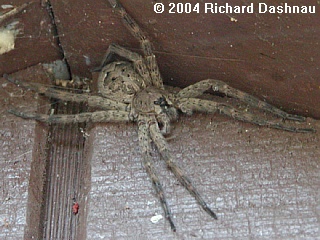
LOOKING DOWN AGAIN
Finally, on October
18, I saw it on the outside again. I didn't see it after that. (see
LOOKING DOWN AGAIN, LOWER LEFT LEG, FACE WITH FANGS, and FACE EVEN CLOSER,
below.)
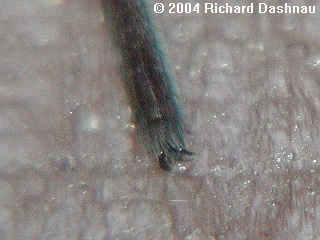 --
--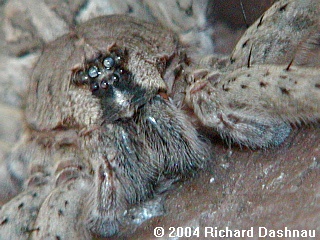 -
-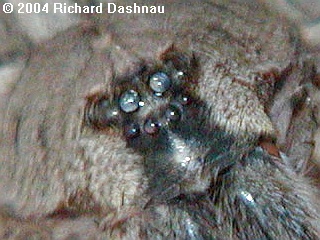 -
-
LOWER LEFT LEG
FACE WITH FANGS
FACE EVEN CLOSER
July
21-20, 2002 I guess we're moving into
our summer weather, although it hasn't broken 100 degrees F yet. The number
of visitors to the park has lessened somewhat. Today, July 21
(Sunday),
I took a few more pictures of some of our Golden Silk Spiders. This picture
shows a pretty big one (see HOW BIG?, above). I took two more pictures
of this one, with different
objects to give a better idea of the size.
(See CATCH MY NAME, and WITH A QUARTER above). These spiders are usually
harmless to humans, but it still gave me some heebie-jeebies
to look through
the camera zoomed in as I moved my hand closer to the spider. I'll
mention here that Ms. Kissane, in our early communication, pointed out
the there is a very poisonous,
and aggressive spider from South America
also known as "Banana Spider", because it has turned up in shipments of
bananas here in the U.S. Please don't start killing the spiders I've
shown
here under the impression that these "Banana Spiders" are the same. They
aren't.
July
7, 2002 Happy 4th of July Weekend! I
was able to go to the park 3 times over the last 4 days. Interesting stuff
happened. (Well, interesting to me, and since this is my
page, I guess
you're going to see some of it.) I'll start with what happened
last. I was talking with Mark and Sharon, sitting on the bench outside
the front door of the VC, when a vertical moving object in
my peripheral
vision caught my attention. I turned to look, and saw what seemed
to be a piece of Spanish Moss slowly moving to the ground. I guess the
slowness of the fall must have
caught my attention. I glanced at it, and
was about to turn back to the conversation, when the "moss" got up and
started hopping/running (see ON THE GROUND,below)! I made a number
of exclamatory
sounds, and all three of us went over to examine the spider. As we got
there, a small red wasp (about 1/2 to 3/4 inches long) started harassing
the spider. It landed behind,
and ran after the spider, it crossed in front,
it circled, and then, it ran under the spider. The spider, meanwhile,
had stopped, and had raised its body up from the ground. Once or twice,
it
lunged at the
--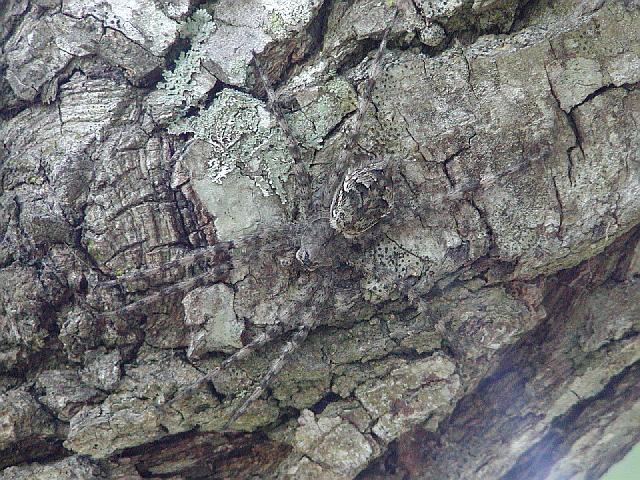 -
-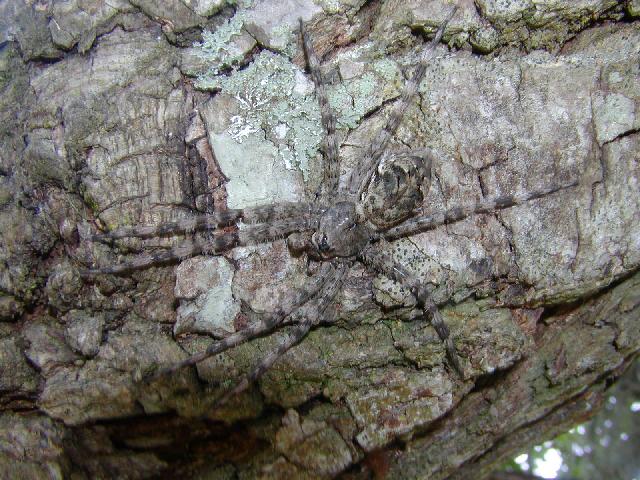 -
-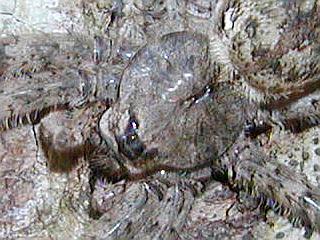 -
-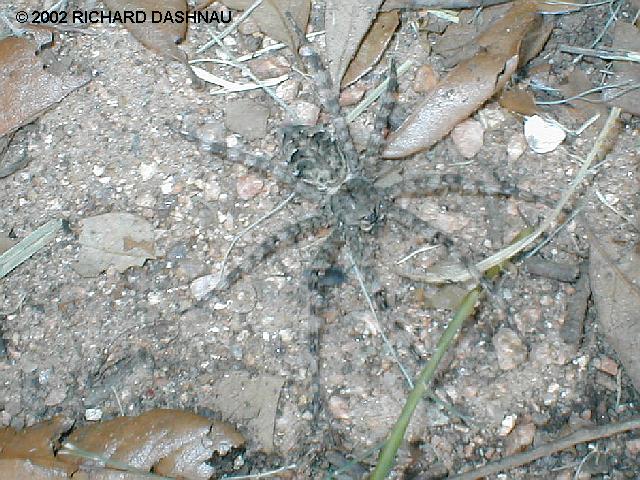 ----
----
WITHOUT
A
FLASH
WITH A
FLASH
CLOSEUP OF
HEAD
ON THE GROUND
wasp,
perhaps biting it (it moved very quickly). The wasp seemed to give up,
and flew away. We examined the spider, and then Mark had it crawl onto
a stick and he put the spider on one of
the Live Oak trees. By then
I had retrieved my camera, and took a few pictures. The rickubiscam this
week shows the spider against the bark. The following pictures show
better detail.
Clicking two of the thumbnail images will show a 640 x 480
image. This spider's camouflage is amazing! I found that taking a
picture with a flash contrasted the spider better against the bark.
Its
coloration blended well also with the conditions on the ground. I
am guessing that this is a variety of wolf spider, mostly because it resembles
one or two varieties that I was able to find
pictures of. If anyone
out there has a better identification, please let me know.
New
information 7/22/2002: Yesterday, I talked
to Sharon (Park Naturalist) about this spider. She suggested that it was
perhaps a "Nursery Web Spider". So, I did some research. I was able to
find some information and pictures on the internet, and in my two spider
books as well. From what I can see, this seems to be a Nursery Web Spider.
Some members of this group are also
called Fishing Spiders. I think it's
one of two species: Dolomedes Tenebrosus, or Dolomedes Albineus. My Golden
Guide to Spiders and Their Kin (Levi) states that D. Tenebrosus lives in
the
U.S. East of the Rocky Mountains; but The Audubon Society Guide to
North American Insects and Spiders gives their range as "New England and
adjacent areas of Canada". I suppose one
could say Texas was adjacent
to Canada if one is speaking on an astronomical scale, but I don't
think they are. I found this website however, which may shed some
light on this
mystery: http://www.dolomedes.org/
On this
website, Ms. Kissane shows a spider that looks very much like the one I
saw, and also mentions that they are one of the few species of Dolomedes
that lives primarily on land (remember,
these are usually called "Fishing
Spiders"), and that they also live in trees in the Southeastern U.S..
Sure sounds like our critter, doesn't it? That would make it D. Albineus.
More
new information 7/22/2002: I had emailed Ms. Kelly C. Kissane and asked
her about this spider. She wrote back (twice! Thanks, Ms. Kissane!) and
said that based on the pictures, and the
head shot, she was comfortable
with the identification as Dolomedes Albineus. Ms. Kissane also said
that D. Tenebrosus' (the other species) range extends further than what
I mentioned above,
and that she's found them "as far south as Southern
Virginia, and as far west as Missouri". However, the one in my pictures
is a "Nursery Web Spider", or "Fishing Spider", or "Whitebanded
Fishing
Spider"--Dolomedes Albineus.
I found
the following classification at this website: http://www.floridanature.org/species.asp?species=Dolomedes_albineus
Kingdom: Metazoa (Animalia)
Phylum: Arthropoda (arthropods)
Class: Arachnida (spiders, harvestmen, scorpions, mites, etc.)
Order: Araneae (spiders)
Family: Pisauridae (nursery web spiders)
Genus: Dolomedes (fishing spiders)
Species: Dolomedes albineus
Common Names: Whitebanded Fishing Spider
Spiders
are turning out to be quite interesting. But, they are difficult to identify
in some cases. I'm also unsure of the differences between the species.
I guess I'll just have to find out more about them.
I guess I'll
also have to become more familiar with taxonomic classification of life,
also.
If you'd like to know more about the park follow these links:
Brazos
Bend State Park The main page.
Brazos
Bend State Park Volunteer's Page The
volunteer's main page.
Click on this image 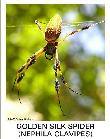 to see a flv video movie (942kb) of a series of 9 11 x 14 posters
I'm working on.
to see a flv video movie (942kb) of a series of 9 11 x 14 posters
I'm working on.
Go back to my home page, Welcome
to rickubis.com
Go
back to the RICKUBISCAM page.
Go
back to the See the World
page.












 --
-- --
-- --
-- -----
----- ---------------------
---------------------











 --
-- -
- -
-



